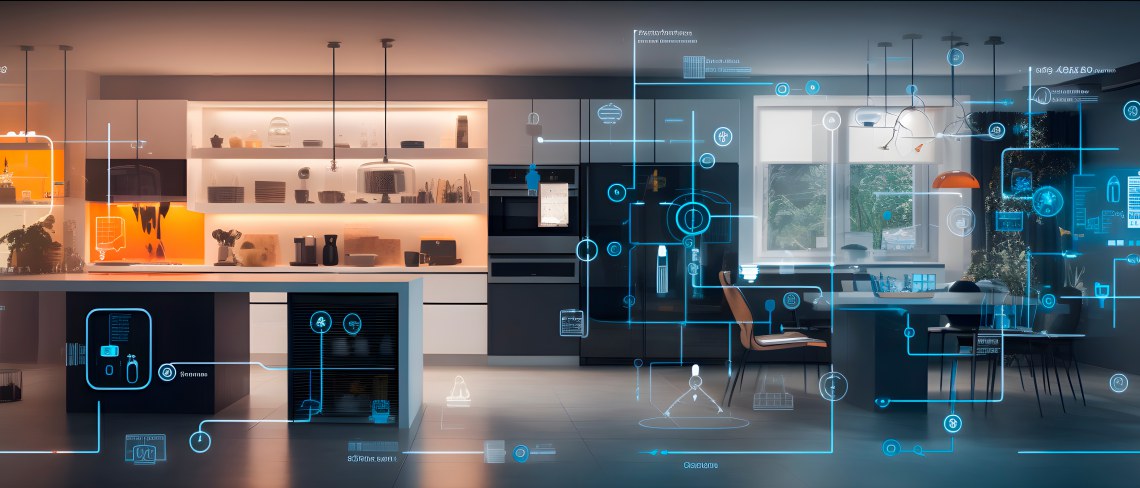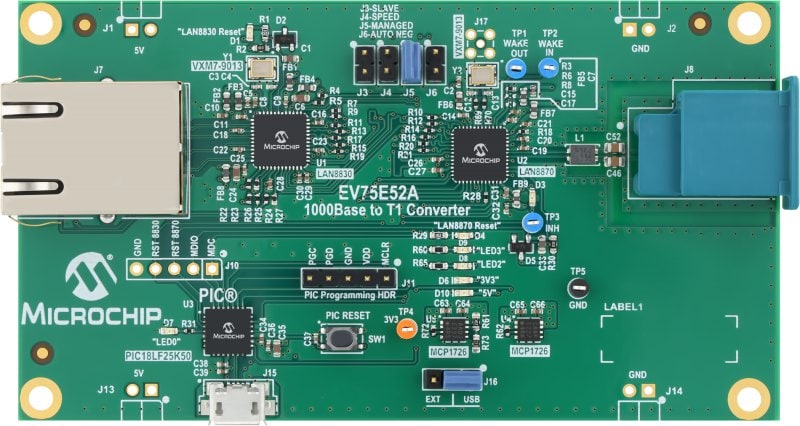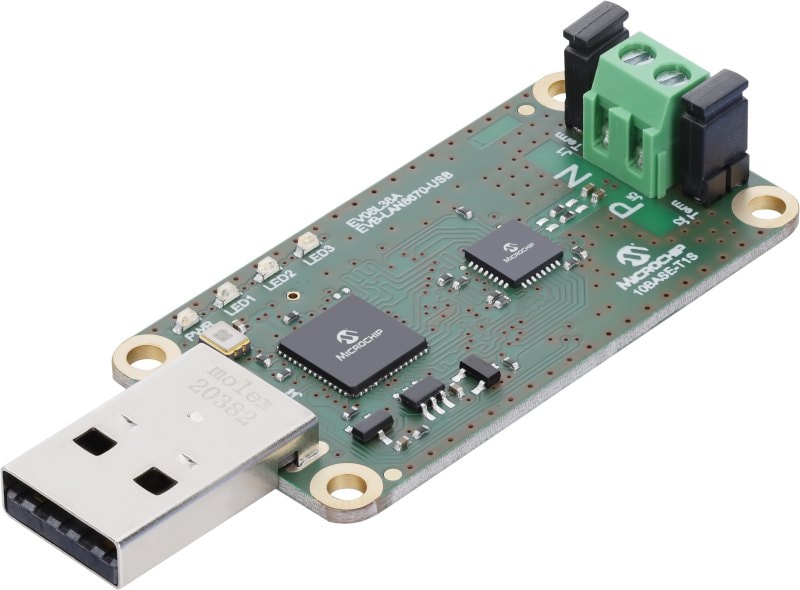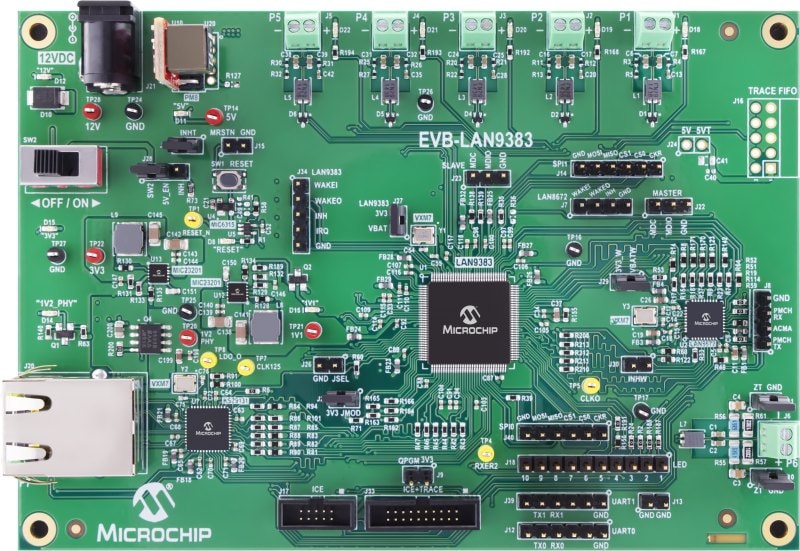Single Pair Ethernet (SPE) Products
What is Single Pair Ethernet?
LAN8870 Type-B 1000BASE-T1 PHY
Explore the LAN8870 Type-B Ethernet physical layer transceiver, featuring an extended cable reach of up to at least 40 meters that exceeds the IEEE 802.3bp specification. Available in both industrial and automotive temperature grades, the LAN8870B is optimized for ADAS, telematics and industrial automation applications.
SPE Standards
IEEE 802.3cg
Protocols:
- 10BASE-T1S
- 10BASE-T1L
Features:
- 10 Mbps connection over a single pair of conductors
- Short reach (25m), multi-drop bus line or point-to-point connection
- Long reach (1 km), point-to-point connection
IEEE 802.3bw
Protocol:
- 100BASE-T1
Features:
- 100 Mbps over single twisted-pair cable
- Up to at least 15m
IEEE 802.3bp
Protocol:
- 1000BASE-T1
Features:
- 1000 Mbps over single twisted-pair cable
- Type A link segment up to at least 15m
- Optional Type B segment up to at least 40m
IEEE 802.3ch
Protocol:
- NGBASE-T1
Features:
- 2.5 Gbps, 5 Gbps, 10 Gbps over single twisted-pair shielded cable
- Up to at least 15m
SPE Benefits
Ease of Design
- Worldwide, open standards-based architecture that is vendor interoperable
- Single port to support several connections
- Avoids using multiple cables from the switch to the connected device
Security
- Well-understood, proven security infrastructure
- Authentication, encryption and secure updates
Support
- Large ecosystem of suppliers and applications
- Compared to proprietary or industry-specific protocols, Ethernet more readily supports the trend toward IP-based IoT edge computing
Key Applications

Industrial Control and Factory Automation
Industrial control and factory automation benefit from simpler components, software and wiring when implementing SPE networking. SPE also eliminates gateways and by using 10BASE-T1S technology for sensors and actuators, you can enable a single wiring run to the sensor/actuator array.

Building Automation
Building automation benefits from Ethernet as there is no need for protocol translation between proprietary protocols. Networks can mix traditional Ethernet and SPE to optimize data and control installations. A large percentage of building control tasks require basic signaling and very low bandwidth. You can meet both of these requirements in a more cost-effective manner using SPE connections.
Use cases in building automation include motion detection and lighting, elevator control, HVAC control and light sensing/window shade control.

Data Centers
Designers of data centers embrace Ethernet for virtually all connectivity needs outside the board level. Use of SPE ensures there is no need for protocol translation between networks while offering cost optimization for tasks that require basic signaling and lower bandwidth.
Many industrial-type applications exist within data center infrastructure, including HVAC controls, motors for zonal controls and sensors that monitor individual zones, racks or pieces of equipment.

Automotive
The automotive industry is steadily moving toward Ethernet as a data backbone within the vehicle. Ethernet offers a scalable, cost-effective and known protocol, which does not require auto OEMs to invest in the development of industry-specific protocols. Protocol-compliant variants like SPE offer additional opportunities for cost optimization and weight reduction for a wide variety of functions that require basic signaling or lower bandwidth.

Industrial Robotics
Robotic handling and motion has become increasingly sophisticated. Multi-axis motion requires many additional motors and actuators. At the same time, sensors in fingertips have enabled robots to handle everything from lightbulbs to iron assemblies. These abilities have required sensors and electronics to be placed in difficult-to-access locations. Connecting all of these components has become one of the major challenges in advanced robotics. SPE offers reduced wire size and significant bandwidth to enable communication between controllers, motors, actuators and sensors.
Demo and Evaluation Boards

The EVB-LAN8870-MC Evaluation Board is a 1000BASE-T1 to 1000BASE-T media converter used in evaluating the LAN8870 1000BASE-T1 Ethernet transceiver.

The EVB-LAN8670-RMII enables 10BASE-T1S Ethernet communication with for instance the SAM E54 Curiosity Ultra Development Board or the SAM E70 Xplained Ultra Evaluation Kit.

The EVB-LAN8670-USB interconnects an USB interface with a 10BASE-T1S Ethernet network interface. The adapter serves as a network card that connects applications via USB 2.0 to the 10BASE-T1S network.

The EVB-LAN9383 is a compact evaluation board for the LAN9383 7-Port AVB/TSN Gigabit Ethernet Switch.